ASUS A7N266-VM, A7N266-VMAA User Manual


 ®
®
A7N266-VM
User Guide
Motherboard

Product Name: |
A7N266-VM |
Manual Revision: |
1.00 E1014 |
Release Date: |
March 2002 |
Copyright © 2002 ASUSTeK COMPUTER INC. All Rights Reserved.
No part of this manual, including the products and software described in it, may be reproduced, transmitted, transcribed, stored in a retrieval system, or translated into any language in any form or by any means, except documentation kept by the purchaser for backup purposes, without the express written permission of ASUSTeK COMPUTER INC. (“ASUS”).
Product warranty or service will not be extended if: (1) the product is repaired, modified or altered, unless such repair, modification of alteration is authorized in writing by ASUS; or (2) the serial number of the product is defaced or missing.
Products and corporate names appearing in this manual may or may not be registered trademarks or copyrights of their respective companies, and are used only for identification or explanation and to the owners’ benefit, without intent to infringe.
The product name and revision number are both printed on the product itself. Manual revisions are released for each product design represented by the digit before and after the period of the manual revision number. Manual updates are represented by the third digit in the manual revision number.
For previous or updated manuals, BIOS, drivers, or product release information, contact ASUS at: http://www.asus.com or through any of the means indicated on the following page.
ASUS PROVIDES THIS MANUAL “AS IS” WITHOUT WARRANTY OF ANY KIND, EITHER EXPRESS OR IMPLIED, INCLUDING BUT NOT LIMITED TO THE IMPLIED WARRANTIES OR CONDITIONS OF MERCHANTABILITY OR FITNESS FOR A PARTICULAR PURPOSE. IN NO EVENT SHALL ASUS, ITS DIRECTORS, OFFICERS, EMPLOYEES OR AGENTS BE LIABLE FOR ANY INDIRECT, SPECIAL, INCIDENTAL, OR CONSEQUENTIAL DAMAGES (INCLUDING DAMAGES FOR LOSS OF PROFITS, LOSS OF BUSINESS, LOSS OF USE OR DATA, INTERRUPTION OF BUSINESS AND THE LIKE), EVEN IF ASUS HAS BEEN ADVISED OF THE POSSIBILITY OF SUCH DAMAGES ARISING FROM ANY DEFECT OR ERROR IN THIS MANUAL OR PRODUCT.
SPECIFICATIONS AND INFORMATION CONTAINED IN THIS MANUAL ARE FURNISHED FOR INFORMATIONAL USE ONLY, AND ARE SUBJECT TO CHANGE AT ANY TIME WITHOUT NOTICE, AND SHOULD NOT BE CONSTRUED AS A COMMITMENT BY ASUS. ASUS ASSUMES NO RESPONSIBILITY OR LIABILITY FOR ANY ERRORS OR INACCURACIES THAT MAY APPEAR IN THIS MANUAL, INCLUDING THE PRODUCTS AND SOFTWARE DESCRIBED IN IT.
ii

About this guide
This user manual contains complete information for installing the ASUS A7N266-VM motherboard.
How this guide is organized
•Chapter 1: Product introduction. A summary of product features and special attributes of new technologies.
•Chapter 2: Hardware information. A list of hardware setup procedures and descriptions of all jumpers and connectors on the motherboard.
•Chapter 3: Powering up. Describes the power up sequence with information on BIOS beep codes.
•Chapter 4: BIOS setup. How to change system settings using onboard BIOS firmware. Detailed descriptions of the BIOS parameters are supplied.
•Chapter 5: Software support. A summary of contents on the motherboard support CD ROM.
•Appendix and Glossary. Optional components and technical definitions.
•Index
Conventions used in this guide
To make sure that you perform set-up tasks properly, take note of the following symbols used throughout this manual.
WARNING! Information to prevent injury to yourself.
CAUTION! Information to prevent damage to the components.
IMPORTANT! Information that you MUST follow to complete a task.
NOTE! Tips and helpful information.
iii

Contents
About this guide .......................................................................................... |
iii |
How this guide is organized ............................................................... |
iii |
Conventions used in this guide .......................................................... |
iii |
Safety information ...................................................................................... |
vi |
FCC/CDC statements ................................................................................. |
vii |
ASUS contact information ......................................................................... |
viii |
Chapter |
1: Product introduction ............................................. |
1 |
Welcome! .................................................................................................... |
1 |
|
1.1 |
Package contents .............................................................................. |
1 |
1.2 |
Core Specifications ........................................................................... |
2 |
1.3 |
Special Features ............................................................................... |
3 |
1.4 |
Motherboard Components ................................................................. |
4 |
|
1.4.1 Component Locations ......................................................... |
5 |
Chapter 2: Hardware information ............................................ |
7 |
||
2.1 |
Motherboard installation .................................................................... |
7 |
|
|
2.1.1 |
Placement direction ............................................................. |
7 |
|
2.1.2 |
Screw holes ......................................................................... |
7 |
2.2 |
Layout contents ................................................................................. |
9 |
|
2.3 |
Before you proceed ......................................................................... |
10 |
|
2.4 |
Central Processing Unit (CPU) ........................................................ |
11 |
|
|
2.4.1 |
Overview ........................................................................... |
11 |
|
2.4.2 |
Installing the CPU .............................................................. |
12 |
2.5 |
System memory .............................................................................. |
13 |
|
|
2.5.1 |
Overview ........................................................................... |
13 |
|
2.5.2 |
Memory configurations ...................................................... |
14 |
|
2.5.3 |
Installing a DIMM ............................................................... |
14 |
2.6 |
Expansion slots ............................................................................... |
15 |
|
|
2.6.1 Installing an expansion card .............................................. |
15 |
|
|
2.6.2 Configuring an expansion card .......................................... |
16 |
|
|
2.6.3 |
PCI slots ............................................................................ |
17 |
|
2.6.4 |
AGP slot ............................................................................ |
18 |
2.7 |
Jumpers |
.......................................................................................... |
19 |
2.8 |
Connectors ...................................................................................... |
23 |
|
Chapter 3: Powering up ......................................................... |
33 |
|
3.1 |
Starting up for the first time .............................................................. |
33 |
3.2 |
Powering off the computer ............................................................... |
34 |
Chapter 4: BIOS setup ........................................................... |
35 |
|
4.1 |
Managing and Updating Your BIOS ................................................. |
35 |
iv

Contents
|
4.1.1 Upon First Use of the Computer System ........................... |
35 |
|
|
4.1.2 |
Updating BIOS Procedures ............................................... |
37 |
4.2 |
BIOS Setup Program ...................................................................... |
39 |
|
|
4.2.1 |
BIOS Menu Bar ................................................................. |
40 |
|
4.2.2 |
Legend Bar ........................................................................ |
40 |
4.3 |
Main Menu ...................................................................................... |
42 |
|
|
4.3.1 Primary & Secondary Master/Slave ................................... |
43 |
|
|
4.3.2 |
Keyboard Features ............................................................ |
47 |
4.4 |
Advanced Menu .............................................................................. |
49 |
|
|
4.4.1 Summary of Warning Messages ......................................... |
51 |
|
|
4.4.2 |
Chip Configuration ............................................................. |
52 |
|
4.4.3 |
I/O Device Configuration ................................................... |
54 |
|
4.4.4 |
PCI Configuration .............................................................. |
56 |
|
4.4.5 |
Shadow Configuration ....................................................... |
58 |
4.5 |
Power Menu .................................................................................... |
59 |
|
|
4.5.1 |
Power Up Control .............................................................. |
61 |
|
4.5.2 |
Hardware Monitor .............................................................. |
62 |
4.6 |
Boot Menu ....................................................................................... |
63 |
|
4.7 |
Exit Menu ........................................................................................ |
65 |
|
Chapter 5: Software support ................................................. |
67 |
||
5.1 |
Install an operating system .............................................................. |
67 |
|
5.2 |
Support CD information ................................................................... |
67 |
|
5.3 |
A7N266-VM Motherboard Support CD ............................................ |
68 |
|
|
5.3.1 |
Installation Menu ............................................................... |
68 |
|
5.3.2 |
Installation Procedure ........................................................ |
69 |
|
5.3.3 Installation of PCI Drivers: Win98 ...................................... |
70 |
|
|
5.3.4 Installation of Audio Codec Drivers: Win98 ........................ |
71 |
|
|
5.3.5 Installation of NVIDIA MCP MAC Driver: Win98 ................. |
72 |
|
|
5.3.6 Installation of NVIDIA GeForce2 GPU Driver: Win98 ......... |
72 |
|
5.4 |
ASUS PC Probe .............................................................................. |
73 |
|
5.5 |
ASUS Live Update .......................................................................... |
78 |
|
5.6 |
3Deep Color Tuner .......................................................................... |
79 |
|
5.7 |
CyberLink PowerPlayer SE ............................................................. |
81 |
|
5.8 |
CyberLink VideoLive Mail ................................................................ |
83 |
|
Chapter 6: Appendix ............................................................... |
85 |
|
6.1 |
Glossary .......................................................................................... |
85 |
6.2 |
Troubleshooting ............................................................................... |
89 |
Index |
........................................................................................ |
91 |
v

Safety information
Electrical safety
•To prevent electrical shock hazard, disconnect the power cable from the electrical outlet before relocating the system.
•When adding or removing devices to or from the system, ensure that the power cables for the devices are unplugged before the signal cables are connected. Disconnect all power cables from the existing system before you add a device.
•Before connecting or removing signal cables from the motherboard, ensure that all power cables are unplugged.
•Seek professional assistance before using an adpater or extension cord. These devices could interrupt the grounding circuit.
•Make sure that your power supply is set to the voltage available in your area.
•If the power supply is broken, contact a qualified service technician or your retailer.
Operational safety
•Before installing the motherboard and adding new devices, carefully read all the manuals that came with the package.
•Before use ensure all cables are correctly connected and the power cables are not damaged. If you detect any damage, contact the dealer immediately.
•To avoid short circuits, keep paper clips, screws, and staples away from connectors, slots, sockets and circuitry.
•Avoid dust, humidity, and temperature extremes. Do not place the product in any area where it may become wet.
•Mount the motherboard inside a standard PC enclosure.
•If you encounter technical problems with the product, contact a qualified service technician or the dealer.
vi

FCC/CDC statements
Federal Communications Commission Statement
This device complies with FCC Rules Part 15. Operation is subject to the following two conditions:
•This device may not cause harmful interference, and
•This device must accept any interference received including interference that may cause undesired operation.
This equipment has been tested and found to comply with the limits for a Class B digital device, pursuant to Part 15 of the FCC Rules. These limits are designed to provide reasonable protection against harmful interference in a residential installation. This equipment generates, uses and can radiate radio frequency energy and, if not installed and used in accordance with manufacturer’s instructions, may cause harmful interference to radio communications. However, there is no guarantee that interference will not occur in a particular installation. If this equipment does cause harmful interference to radio or television reception, which can be determined by turning the equipment off and on, the user is encouraged to try to correct the interference by one or more of the following measures:
•Reorient or relocate the receiving antenna.
•Increase the separation between the equipment and receiver.
•Connect the equipment to an outlet on a circuit different from that to which the receiver is connected.
•Consult the dealer or an experienced radio/TV technician for help.
The use of shielded cables for connection of the monitor to the graphics card is required to assure compliance with FCC regulations. Changes or modifications to this unit not expressly approved by the party responsible for compliance could void the user’s authority to operate this equipment.
Canadian Department of Communications Statement
This digital apparatus does not exceed the Class B limits for radio noise emissions from digital apparatus set out in the Radio Interference Regulations of the Canadian Department of Communications.
This class B digital apparatus complies with Canadian ICES-003.
vii

ASUS contact information
ASUSTeK COMPUTER INC. (Asia-Pacific)
Marketing
Address: |
150 Li-Te Road, Peitou, Taipei, Taiwan 112 |
Telephone: |
+886-2-2894-3447 |
Fax: |
+886-2-2894-3449 |
Email: |
info@asus.com.tw |
Technical Support
Tel (English): |
+886-2-2890-7123 |
Tel (Chinese): |
+886-2-2890-7113 |
Fax: |
+886-2-2890-7698 |
Email: |
tsd@asus.com.tw |
Newsgroup: |
cscnews.asus.com.tw |
WWW: |
www.asus.com.tw |
FTP: |
ftp.asus.com.tw/pub/ASUS |
ASUS COMPUTER INTERNATIONAL (America)
Marketing
Address: |
6737 Mowry Avenue, Mowry Business Center, Building 2 |
|
Newark, CA 94560, USA |
Fax: |
+1-510-608-4555 |
Email: |
info-usa@asus.com.tw |
Technical Support
Fax: |
+1-510-608-4555 |
BBS: |
+1-510-739-3774 |
Email: |
tsd@asus.com |
WWW: |
www.asus.com |
FTP: |
ftp.asus.com/pub/ASUS |
ASUS COMPUTER GmbH (Europe)
Marketing
Address: |
Harkortstr. 25, 40880 Ratingen, BRD, Germany |
Fax: |
+49-2102-442066 |
Email: |
sales@asuscom.de (for marketing requests only) |
Technical Support
Hotline: |
MB/Others: +49-2102-9599-0 |
|
Notebook: +49-2102-9599-10 |
Fax: |
+49-2102-9599-11 |
Support (Email): |
www.asuscom.de/de/support (for online support) |
WWW: |
www.asuscom.de |
FTP: |
ftp.asuscom.de/pub/ASUSCOM |
viii
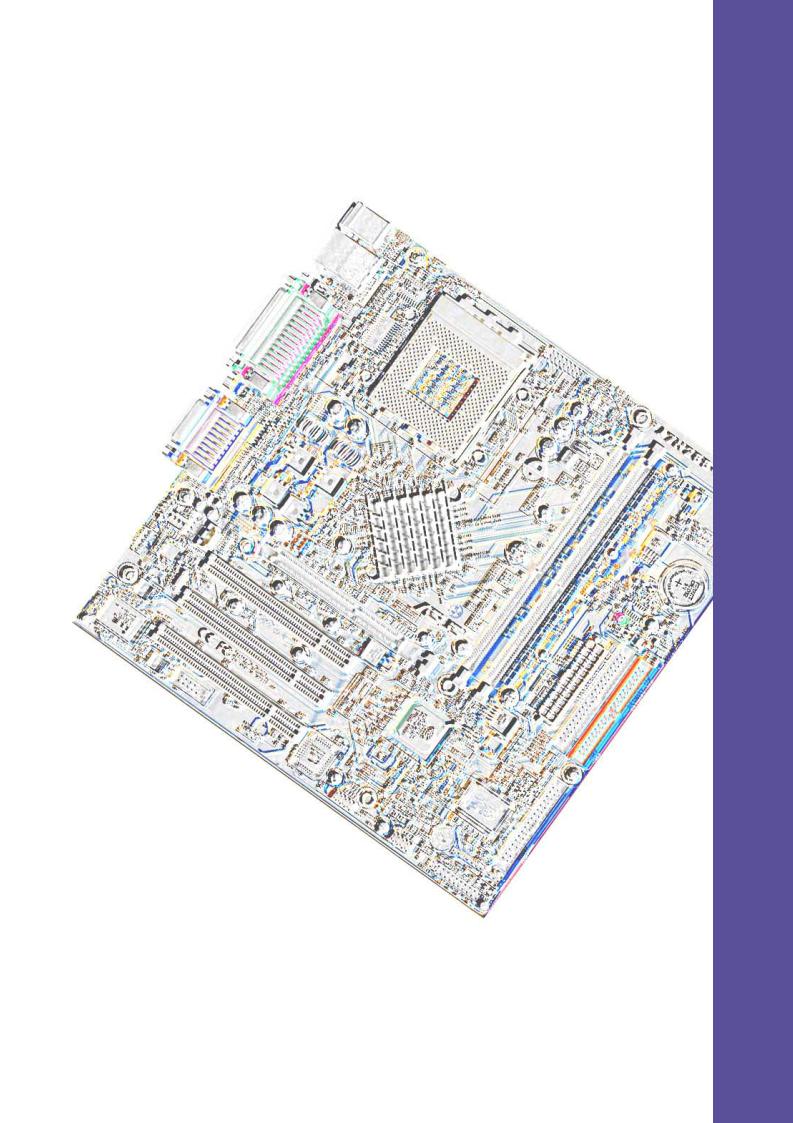
Chapter 1
Product introduction

ASUS A7N266-VM motherboard

Welcome!
Thank you for buying the ASUS® A7N266-VM motherboard!
The A7N266-VM is powered by AMD® Athlon™ , Athlon™ XP and Duron™ processors and supplies advanced features to ensure long-lasting, superlative performance. The ASUS® A7N266-VM motherboard is the prime choice for home PCs and workstations.
~Up to 1GB of system memory of the latest DDR RAM
~High-resolution graphics via an AGP 4X slot
~Digital Audio Interface for 3D sound
~Onboard LAN PHY for instant networking (Optional)
~Four USB ports plus one header for two more
~UltraDMA100 data rates
The A7N266-VM is the perfect vehicle to get ahead in the world of power computing!
1.1Package contents
Check your A7N266-VM package for the following items.
ASUS A7N266-VM motherboard (MicroATX form factor: 9.6 in x 9.6 in)
ASUS A7N266-VM support CD
ASUS 2-port USB module
40-conductor IDE cable
Ribbon cable for a 3.5-inch floppy drive
COM 2 bracket
I/O shield (LAN model only)
Bag of extra jumper caps
User Guide
If any of the above items is damaged or missing, contact your retailer.
ASUS A7N266-VM motherboard user guide |
1 |

1.2Core Specifications
The A7N266-VM motherboard is designed and assembled according to the highest standards. This ASUS motherboard represents the latest advances and offers users the finest componentry available today...
AMD® Athlon™ / Athlon™ XP and Duron™ Socket A (462) Processor
North Bridge Chipset: the nVidia® 220D GeForce MX Integrated GPU/ North Bridge controller chipset. The controller supports a 64bit DDR memory controller and up to 1 GB of 266/200MHz DDR SDRAM memory. The 64bit memory controller provides a exceptional 2.1 GB/second system memory bandwidth.
South Bridge Chipset: Features the brand new nVidia® nForce™ MCP-D integrated peripheral South Bridge controller operates at 800MB/ sec to communicate with the North Bridge for maximum bandwith required for PCI, USB and support for Fast Ethernet devices. The chipset has an integrated APU (Audio Processing Unit) for Dolby™ digital encoding. The controller supports standard UltraDMA/100/66/33 for burst mode data transfer rates of up to 100MB/sec. Separate data paths for each IDE channel are built-in for up to four IDE devices. The controller supports six USB ports and is PCI rev 2.2 compliant. The MCP supplies an LPC 1.0 interface along with AT legacy functions, a clock synthesizer and meets ACPI 1.0 and PCI Power Management 1.1 specifications.
PC2100 / PC1600 DDR Support: Equipped with two Double Data Rate Dual Inline Memory Module (DDR DIMM) sockets to support up to 1GB of DDR DRAM, the newest memory standard with the highest bandwidth and lowest latency currently available. This new memory technology increases performance by executing two actions per clock cycle, resulting in data transfer rates of up to 2.1 GB/s for 133MHz DDR SDRAM and 1.6GB/s for 100MHz DDR SDRAM.
UltraDMA/100 Support: Comes with an onboard PCI Bus Master IDE controller with two connectors that support four IDE devices on two channels. Supports UltraDMA100/66/33, PIO Modes 3 & 4, Bus Master IDE DMA Mode 2, and Enhanced IDE devices, such as DVD-ROM, CDROM, CD-R/RW, LS-120, and Tape Backup drives.
Multi-I/O Chipset: Offers complete support for a variety of I/O functions. Provides two high-speed UART compatible serial ports and one parallel port with EPP and ECP capabilities. UART2 can also be directed from COM2 to the Infrared Module for wireless connections. The Super I/O controller supports a floppy disk drive, PS/2 keyboard, and PS/2 mouse.
Connections: Parallel Port, PS/2 mouse Port, PS/2 keyboard, 2 USB ports, Microphone, Line In Jack, Line Out Jack, Standard ATX power.
2 |
Chapter 1: Product introduction |

Expansion: One AGP 4X, four USB ports, three PCI slots, S/PDIF digital audio connector, front audio panel connector, infrared port.
1.3Special Features
Temperature, Fan and Voltage Monitoring: CPU temperature is monitored by ASUS ASIC through a thermal sensor mounted under the CPU. The sensor signals the computer to prevent overheating and damage. The CPU and system fans can be monitored for RPM and failure. System voltage levels are monitored to ensure stable current to critical motherboard components.
ACPI Ready: Advanced Configuration Power Interface (ACPI) provides more Energy Saving Features for operating systems that support OS Direct Power Management (OSPM).
Concurrent PCI: Concurrent PCI allows multiple PCI transfers from PCI master busses to the memory and processor.
Auto Fan Off: The system fans powers off automatically even in sleep mode.
Dual Function Power Button: Push the power button for less than 4 seconds when the system is operating places the system into sleep or soft-off modes; press the power button for more than 4 seconds, and the system enters the soft-off mode regardless of the BIOS setting.
Dolby™ Integrated Audio
nVidia® GeForce2 MX™ Integrated VGA technology
ASUS A7N266-VM motherboard user guide |
3 |

1.4Motherboard Components
Before installing the A7N266-VM motherboard, take time to familiarize yourself with its configuration: understanding the motherboard makes upgrading easy. Sufficient knowledge of specifications prevents accidental damage.
|
|
|
Location |
|
Processor Support |
Socket A for AMD® Athlon™ and Duron™ Processors |
....... 1 |
||
Chipsets |
nVidia® 220D North Bridge .............................................. |
|
2 |
|
|
Realtek 8201L PHY controller ........................................ |
|
3 |
|
|
2Mbit Programmable Flash EEPROM .......................... |
|
13 |
|
|
Multi-I/O controller ......................................................... |
|
15 |
|
Main Memory |
Maximum 1GB support |
|
|
|
|
2 DDR DIMM Sockets ..................................................... |
|
4 |
|
Expansion Slots |
3 |
PCI Slots .................................................................... |
|
16 |
|
1 Accelerated Graphics Port (AGP) 4X Slot |
.................. |
20 |
|
System I/O |
2 |
IDE Connectors (UltraDMA100/66 Support) ................ |
7 |
|
|
1 |
Floppy Disk Drive Connector ....................................... |
|
8 |
|
1 |
System Panel Connector ............................................. |
|
9 |
|
USB Headers (Ports 2/3, 4/5) ....................................... |
|
11 |
|
|
1 COM2 Header ............................................................ |
|
14 |
|
|
1 |
PS/2 Mouse Connector ................................. |
(green) 21 |
|
|
1 |
PS/2 Keyboard Connector .......................... |
(purple) 31 |
|
|
1 |
Parallel Port ................................................................ |
|
23 |
|
1 |
Serial Ports (COM1) ................................................... |
|
29 |
|
USB Connectors (Ports 0/1) .......................................... |
|
30 |
|
Hardware Monitoring System Voltage Monitor (integrated in ASUS ASIC) ..... |
10 |
|||
Special Feature |
Onboard LED .................................................................. |
|
6 |
|
Audio Features |
(on audio models only) |
|
|
|
|
Audio Connectors .......................................................... |
|
19 |
|
|
2-CH Audio Controller .................................................. |
|
18 |
|
|
1 ASUS Front Audio Panel Connector .......................... |
|
17 |
|
|
1 |
Line Out Connector ......................................... |
(lime) 27 |
|
|
1 |
Line In Connector ................................... |
(light blue) 26 |
|
|
1 |
Microphone Connector .................................... |
(pink) 25 |
|
Power |
ATX Power Supply Connector ......................................... |
|
5 |
|
Form Factor |
Micro-ATX |
|
|
|
NOTE: Software driver support for the 6-CH audio system is available for downloading at the ASUS website: www.asus.com
4 |
Chapter 1: Product introduction |
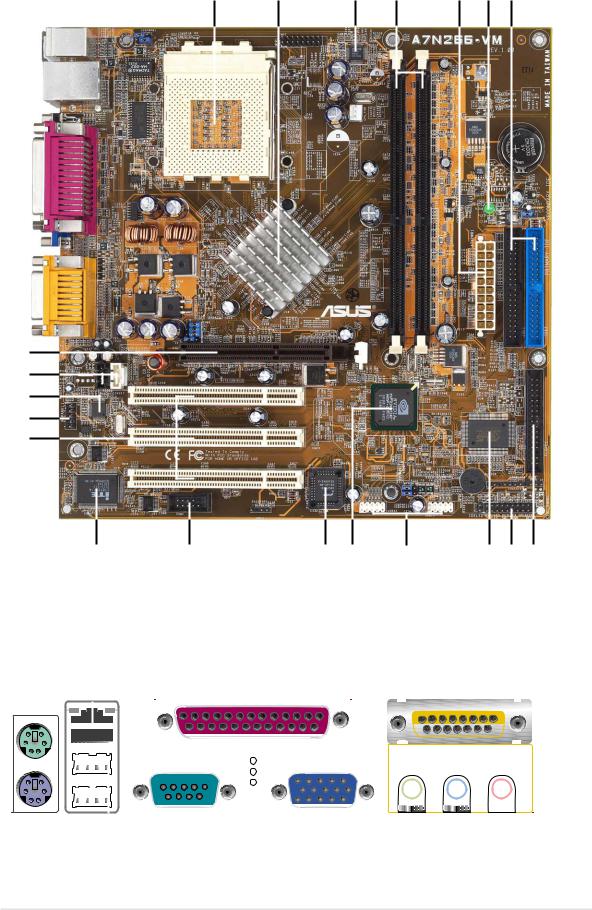
1.4.1 Component Locations
1 |
2 |
3 |
4 |
5 |
6 |
7 |
20
19
18
17
16
15 |
14 |
13 12 |
11 |
10 9 |
8 |
21 |
|
22 |
|
|
23 |
|
|
|
|
|
|
|
|
24 |
|
|
|
|
||||||||||||||||||||||||
|
|
|
|
|
|
|
|
|
|
|
|
|
|
|
|
|
|
|
|
|
|
|
|
|
|
|
|
|
|
|
|
|
|
|
|
|
|
|
|
|
|
|
|
|
|
|
|
|
|
|
|
|
|
|
|
|
|
|
|
|
|
|
|
|
|
|
|
|
|
|
|
|
|
|
|
|
|
|
|
|
|
|
|
|
|
|
|
|
|
|
|
|
|
|
|
|
|
|
|
|
|
|
|
|
|
|
|
|
|
|
|
|
|
|
|
|
|
|
|
|
|
|
|
|
|
|
|
|
|
|
|
|
|
|
|
|
|
|
|
|
|
|
|
|
|
|
|
|
|
|
|
|
|
|
|
|
|
|
|
|
|
|
|
|
|
|
|
|
|
|
|
|
|
|
|
|
|
|
|
|
|
|
|
|
|
|
|
|
|
|
|
|
|
|
|
|
|
|
|
|
|
|
|
|
|
|
|
|
|
|
|
|
|
|
|
|
|
|
|
|
|
|
|
|
|
|
|
|
|
|
|
|
|
|
|
|
|
|
|
|
|
|
|
|
|
|
|
|
|
|
|
|
|
|
|
|
|
|
|
|
|
|
|
|
|
|
|
|
|
|
|
|
|
|
|
|
|
|
|
|
|
|
|
|
|
|
|
|
|
|
|
|
|
|
|
|
|
|
|
|
|
|
|
|
|
|
|
|
|
|
|
|
|
|
|
|
|
|
|
|
|
|
|
|
|
|
|
|
|
|
|
|
|
|
|
|
|
|
|
|
|
|
|
|
|
|
|
|
|
|
|
|
|
|
|
|
|
|
|
|
|
|
|
|
|
|
|
|
|
|
|
|
|
|
|
|
|
|
|
|
|
|
|
|
|
|
|
|
|
|
|
|
|
|
|
|
|
|
|
|
|
|
|
|
|
|
|
|
|
|
|
|
|
|
|
|
|
|
|
|
|
|
|
|
|
|
|
|
|
|
|
|
|
|
|
|
|
|
|
|
|
|
|
|
|
|
|
|
|
|
|
|
|
|
|
|
|
|
|
|
|
|
|
|
|
|
|
|
|
|
|
|
|
|
|
|
|
|
|
|
|
|
|
|
|
|
|
|
|
|
|
|
|
|
|
|
|
|
|
|
|
|
|
|
|
|
|
|
|
|
|
|
|
|
|
|
|
|
|
|
|
|
|
|
|
|
|
|
|
|
|
|
|
|
|
|
|
|
|
|
|
|
|
|
|
|
|
|
|
|
|
|
|
|
|
|
|
|
|
|
|
|
|
|
|
|
|
|
|
|
|
|
|
|
|
|
|
|
|
|
|
|
|
|
|
|
|
|
|
|
|
|
|
|
|
|
|
|
|
|
|
|
|
|
|
|
|
|
|
|
|
|
|
|
|
|
|
|
|
|
|
|
|
|
|
|
|
|
|
|
|
|
|
|
|
|
|
|
|
|
|
|
|
|
|
|
|
|
|
|
|
|
|
|
|
|
|
|
|
|
|
|
|
|
|
|
|
|
|
|
|
|
|
|
|
|
|
|
|
|
|
|
|
|
|
|
|
|
|
|
|
|
|
|
|
|
|
|
|
|
|
|
|
|
|
|
|
|
|
|
|
|
|
|
|
|
|
|
|
|
|
|
|
|
|
|
|
|
|
|
31 |
30 |
29 |
28 |
27 |
26 |
25 |
ASUS A7N266-VM motherboard user guide |
5 |

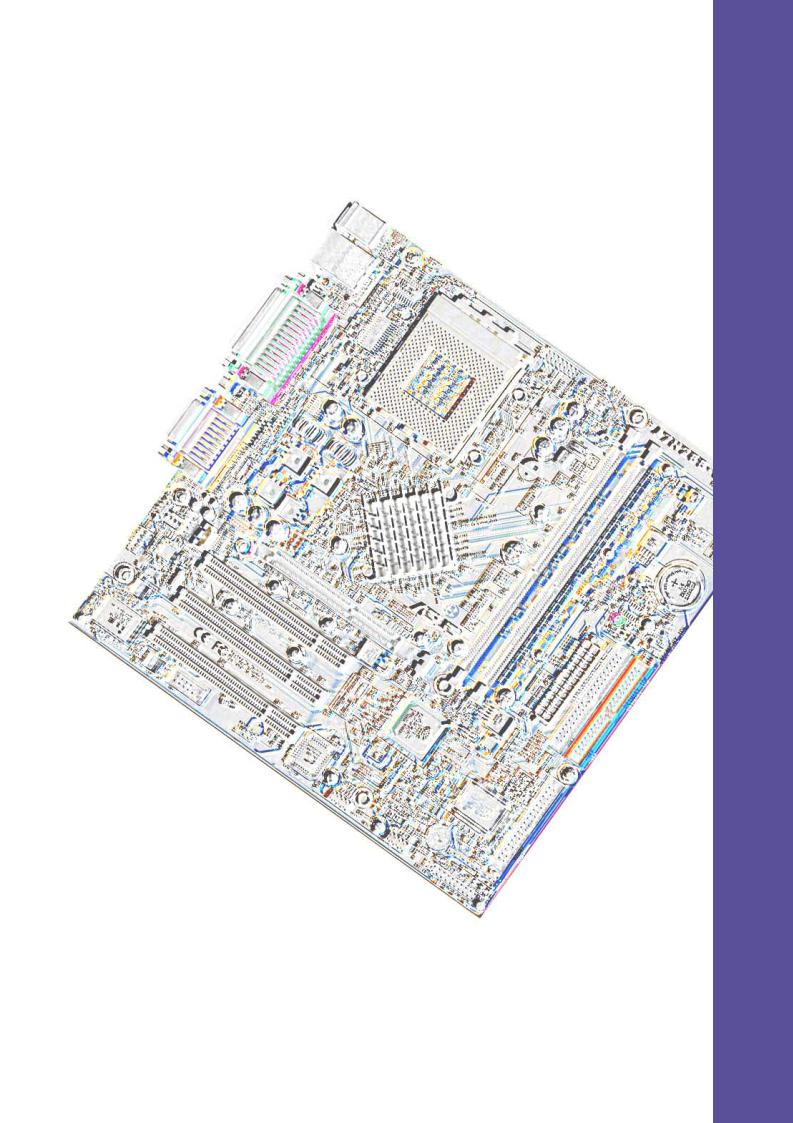
Chapter 2
Hardware information

ASUS A7N266-VM motherboard
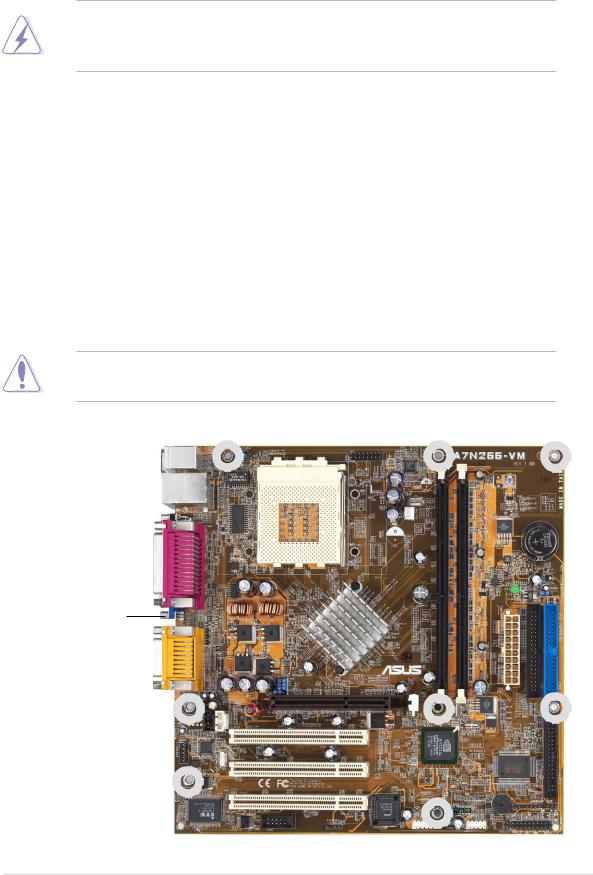
2.1Motherboard installation
The A7N266-VM uses the Micro-ATX form factor, measuring 24.5 cm (9.6 in.) x 24.5 cm (9.6 in.) - a standard fit for most large chassis.
WARNING! Unplug the power cord before installing the motherboard. Failure to do so may cause you physical injury and damage motherboard components.
2.1.1 Placement direction
When installing the motherboard, take care to orient the chassis correctly: The edge with external ports goes to the rear part of the chassis. Refer to the image below. It may be more convenient to install major cables, the CPU and modular components before fixing the motherboard inside the case frame.
2.1.2 Screw holes
Place eight (8) screws into the holes indicated by circles to secure the motherboard to the chassis.
CAUTION! Do not overtighten the screws! Doing so may damage the motherboard.
Place this side towards the rear of the chassis
ASUS A7N266-VM motherboard user guide |
7 |
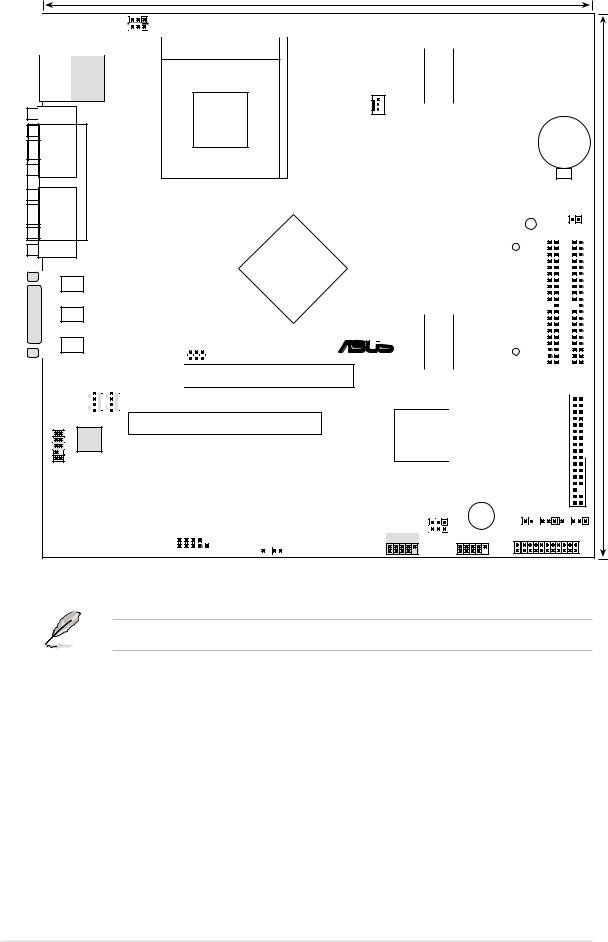
24.5cm (9.64in)
|
|
|
|
|
USBPWR01 |
|
|
|
|
|
|
||
|
PS/2 |
|
|
|
KBPWR1 |
|
T: Mouse |
|
|
|
|
|
|
B: Keyboard |
|
|
|
|
Socket 462 |
|
|
|
|
|
|
|
|
Bottom: |
Top: |
USB1 |
RJ-45 |
USB2 |
|
COM1 |
|
|
PARALLEL PORT |
VGA |
nVidia |
|
|
|
|
|
|
|
|
|
|
|
|
|
220D |
AUDIO |
Line |
|
|
|
|
|
|
|
|
|
Chipset |
|
Out |
|
|
|
|
|
|
|
|
|
|
_ |
Line |
|
|
|
|
|
|
|
|
|
|
In |
|
|
|
|
|
|
|
|
|
|
|
GAME |
|
|
|
|
|
|
|
|
|
|
|
In |
|
|
|
|
|
|
|
|
|
|
|
|
Mic |
|
|
|
|
|
|
|
|
|
|
|
|
|
|
|
|
BSEL0 |
|
|
|
|
|
|
|
|
|
|
|
|
|
|
|
|
|
|
|
|
|
|
|
BSEL1 |
|
|
|
|
Accelerated Graphics Port |
|
|
|
|
|
|
|
|
|
|
||
|
|
|
|
|
|
|
|
|
|
|
|
|
CD_IN1 AUDIO_COM1 |
|
|
|
|
(AGP) |
|||||
|
|
|
|
|
|
|
|
|
|
|
|
|
|
|
|
|
|
|
|
|
|
|
|
|
|
|
|
|
|
|
|
|
|
|
|
PCI 1
Audio
Codec
|
|
|
AAPANEL1 |
PCI 2 |
|
|
||
|
|
|
CPU_FAN

 ®
®
A7N266-VM
|
module) |
|
|
module) |
|
|
|
|
CR2032 3V |
|
|||||||
|
|
|
|
|
|
|
|
|
Lithium Cell |
|
|||||||
|
-pin |
|
|
-pin |
|
|
|
CMOS Power |
|
||||||||
|
|
|
|
|
ConnectorPowerATX |
|
|
|
|
|
|
PrimaryIDE |
(12.0in)30.5cm |
||||
|
(64/72DIMM1DDRbit, 184 |
|
|
(64/72DIMM2DDRbit, 184 |
|
|
CLRTC |
||||||||||
|
|
|
|
|
|
|
|
|
|
|
|
||||||
|
|
|
|
|
|
PLED |
|
|
|
|
|
|
|
|
|
||
|
|
|
|
|
|
|
|
|
|
|
|
|
|
|
|||
|
|
|
|
|
|
|
|
|
|
|
|
|
|
|
|
|
|
|
|
|
|
|
|
|
|
|
|
|
|
|
|
|
|
|
|
|
|
|
|
|
|
|
|
|
|
|
|
|
|
|
|
|
|
|
|
|
|
|
|
|
|
|
|
|
|
|
|
|
|
|
|
|
|
|
|
|
|
|
|
|
|
|
|
|
|
|
|
|
|
|
0 1 |
|
2 3 |
|
|
|
IDE |
|
|
|
|
|
|
|
|
|
|
|
|
|
|
|
|
|
|
|
|||||||||
nVidia |
|
|
|
|
|
Secondary |
|
FLOPPY |
|
|
|
|
|
|
|||
|
|
|
|
|
|
|
|
|
|
||||||||
|
|
|
|
|
|
|
|
|
|||||||||
MCP-D |
|
|
|
|
|
|
|
|
|
|
|
|
|
|
|
||
Chipset |
|
|
|
|
ASUS |
|
|
|
|
|
|
|
|
|
|||
|
|
|
|
|
|
|
ASIC |
|
|
|
|
|
|
|
|
|
|
|
|
|
|
|
|
|
|
|
|
|
|
|
|
|
|||
|
|
|
|
|
|
with Hardware |
|
|
|
|
|
|
|
||||
|
|
|
|
|
|
|
Monitor |
|
|
|
|
|
|
|
|
|
|
|
|
|
|
|
|
|
|
|
|
|
|
|
|
|
|
|
|
|
|
|
|
|
PCI 3 |
|
|
|
2Mb |
||||
Super |
|
|
|
|
|
|
|
||||||
I/O |
|
COM2 |
|
|
|
|
|
|
|
|
|
|
BIOS |
|
|
|
|
|
|
|
|
|
|
|
|||
|
|
|
|
|
|
|
|
|
|
|
|
|
|
|
|
|
|
|
|
|
|
|
|
|
SPDIF1 |
||
USBPWR23 BUZZER |
|
|
|
USBPWR45 |
SMB |
IR |
|
USB45 |
USB23 |
IDELED |
PANEL |
|
|
|
|
Optional components are grayed in the above motherboard layout.
8 |
Chapter 2: Hardware information |

2.2Layout contents
CPU, Memory and Expansion Slots
1) |
Socket 462 |
p. 12 CPU Support |
||
2) |
DIMM 1/2 |
p. 14 System Memory Support |
||
3) |
PCI 1/2/3 |
p. 18 32-bit PCI Bus Expansion Slots |
||
4) |
AGP 4x |
p. 18 Accelerated Graphics Slot |
||
Motherboard Settings (Switches and Jumpers) |
||||
1) |
BSEL0, BSEL1 |
p. 19 |
CPU:DRAM Frequency Setting (Various) |
|
2) |
KBPWR |
p. 20 Keyboard Wake Up (+5V / +5VSB) |
||
3) |
USBPWR_01,_23,_45 |
p. 21 USB Device Wake-up (Disable/Enable) |
||
4) |
CLRTC |
p. 22 Clear RTC RAM (CLRTC) |
||
Connectors |
|
|
|
|
1) |
PS2KBMS |
p. 23 PS/2 Mouse Port (6 pin female) |
||
2) |
PS2KBMS |
p. 23 PS/2 Keyboard Port (6 pin female) |
||
3) |
USB |
p. 24 |
Universal Serial Bus Ports 0, 1 (Two x 4 pin female) |
|
4) |
COM1 / COM2 |
p. 24 Serial Ports (One 9-pin, One 10-1 pin) |
||
5) |
VGA |
p. 25 |
Monitor Output Connector (Blue 15-pin) |
|
6) |
PRINTER |
p. 25 |
Parallel Port (25 pin female) |
|
7) |
GAME_AUDIO |
p. 25 Game/MIDI Ports (Gold 15-pin) (Optional) |
||
8) |
AUDIO |
p. 26 Audio Connectors (Three 1/8” AUDIO) (Optional) |
||
9) |
IDELED |
p. 26 IDE Activity LED (Two 40-1 pin) |
||
10) |
FLOPPY |
p. 27 Floppy Disk Drive Connector (34-1 pin) |
||
11) |
PRIMARY / SEC. IDE |
p. 27 IDE Connectors (Two 40-1 pin) |
||
12) |
CPU_FAN |
p. 28 CPU Fan Connector (3 pin) |
||
13) |
AAPANEL |
p. 28 ASUS Front Panel Audio Connector (10 pin) |
||
14) |
ATXPWR |
p. 29 ATX Power Supply Connector (20 pin) |
||
15) |
SMB |
p. 29 SMBus Connector (6-1 pin) |
||
16) |
CD_IN1, AUX |
p. 30 Internal Audio Connectors (Two 4 pin) (Optional) |
||
17) |
SPDIF1 |
p. 30 Digital Audio Interfaces (4-1 pin SPDIF1) (Optional) |
||
18) |
USB_23, _45 |
p. 31 USB Headers (Two 10-1 pin) |
||
18) |
IR |
p. 31 Infrared module connector (Two 5-1 pin) |
||
20) |
PWR_LED (Panel) |
p. 32 System Power LED Lead (3-1 pin) |
||
21) |
KEYLOCK (Panel) |
p. 32 Keyboard Lock Switch Lead (2 pin) |
||
22) |
SPEAKER (Panel) |
p. 32 System Warning Speaker Lead (4 pin ) |
||
23) |
LED (Panel) |
p. 32 System Message LED Lead (2 pin) |
||
24) |
SMI (Panel) |
p. 32 System Management Interrupt Lead (2 pin) |
||
25) |
PWR (Panel) |
p. 32 ATX Power Switch / Soft-Off Switch Lead (2 pin) |
||
26) |
RESET (Panel) |
p. 32 Reset Switch Lead (2 pin) |
||
ASUS A7N266-VM motherboard user guide |
9 |
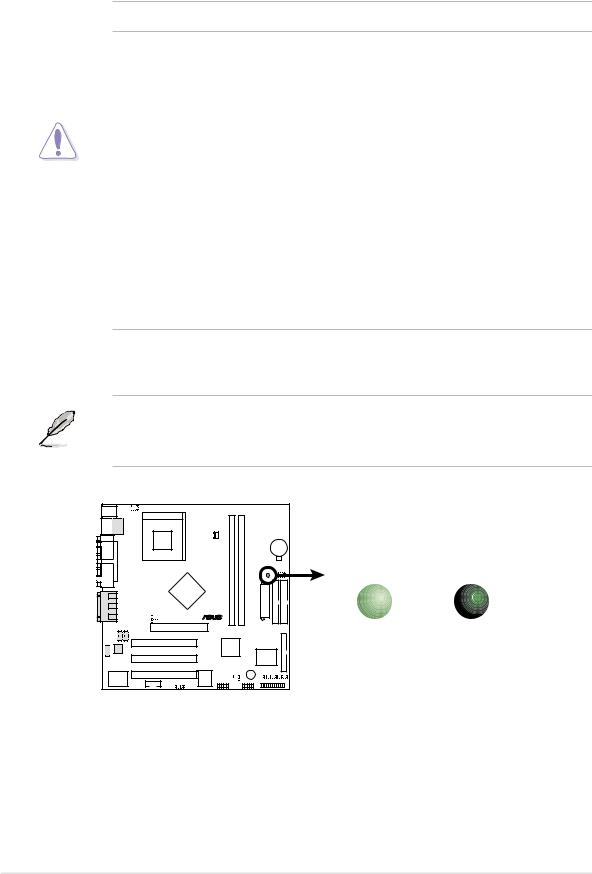
2.3Before you proceed
Take note of the following precautions before you install motherboard components or change any motherboard settings.
CAUTION!
1.Unplug the power cord from the wall socket before touching any component.
2.Use a grounded wrist strap or touch a safely grounded object or to a metal object, such as the power supply case, before handling
components to avoid damaging them due to static electricity.
3.Hold components by the edges and do not to touch the ICs on them.
4.Whenever you uninstall any component, place it on a grounded antistatic pad or in the bag that came with the component.
5.Before you install or remove any component, ensure that the ATX power supply is switched off or the power cord is detached from the power supply. Failure to do so may cause severe damage to the motherboard, peripherals, and/or components.
NOTE! When lit, the onboard LED indicates that the system is ON, in sleep mode or in soft-off mode, not powered OFF. See the illustration below.
A7N266-VM |
|
PLED |
ON |
OFF |
Standby |
Powered |
Power |
Off |
A7N266-VM Onboard LED
10 |
Chapter 2: Hardware information |
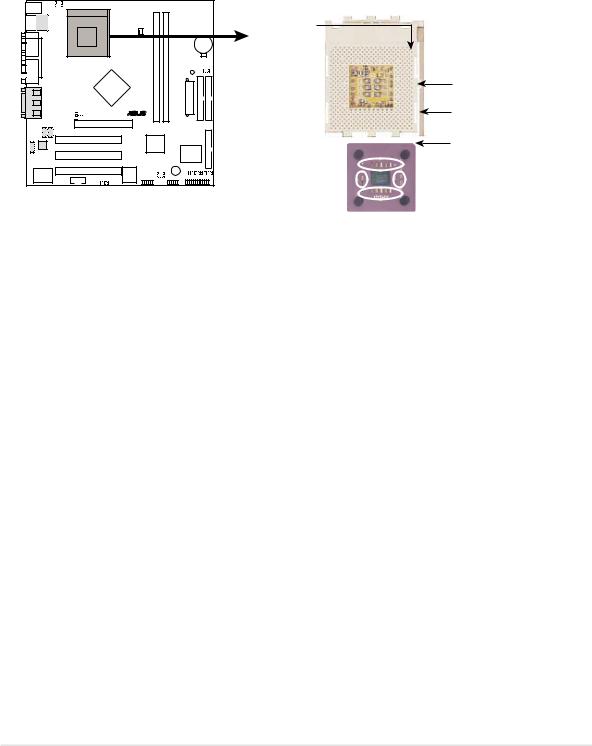
2.4Central Processing Unit (CPU)
2.4.1 Overview
The motherboard provides a Socket A (462) for CPU installation. AMD processors offer gigahertz speeds to support all the latest computing platforms and applications. The A7N266-VM supports Athlon™ XP processors with “QuantiSpeed” data processing, large data caches, 3D enhancements and 266Mhz bus speeds.
A7N266-VM
CPU NOTCH
TO INNER
CORNER
LOCK
LEVER
CPU NOTCH
AMD™ CPU
A7N266-VM Socket 462
Each AMD CPU has a “marked” corner. This corner is usually indicated with a notch, and/or a golden square or triangle. Refer to this indicator while orienting the CPU. See the next page for installation details.
A fan and heatsink should be attached to the CPU to prevent overheating.
ASUS A7N266-VM motherboard user guide |
11 |

2.4.2 Installing the CPU
Follow these steps to install a CPU:
1.Locate the Socket 462 and open it by pulling the lever gently sideways away from the socket. Then lift the lever upwards. The socket lever must be fully opened (90 to 100 degrees).
2.Insert the CPU with the correct orientation. The notched or golden corner of the CPU must be oriented toward the inner corner of the socket base nearest to the lever hinge.
CAUTION! The CPU should drop easily into place. Do not force the CPU into the socket to avoid bending the pins. If the CPU does not fit, check its alignment and look for bent pins.
4.Once completely inserted, press the CPU firmly and close the socket lever until it snaps shut.
5.Place the CPU fan and heatsink on the CPU. The heatsink should entirely cover the CPU. Carefully attach the heatsink locking brace to the plastic clips on the socket base. With the added weight of the CPU fan and heatsink locking brace, no extra force is required to keep the CPU in place
CAUTION! Take care not to scrape the motherboard surface when mounting a clamp-style processor fan, or else damage may occur. When mounting a heatsink onto your CPU, make sure that exposed CPU capacitors do not touch the heatsink, or damage may occur!
NOTE! Do not neglect to set the correct Bus Frequency and leave the CPU Multiple setting at default to avoid start-up problems.
12 |
Chapter 2: Hardware information |
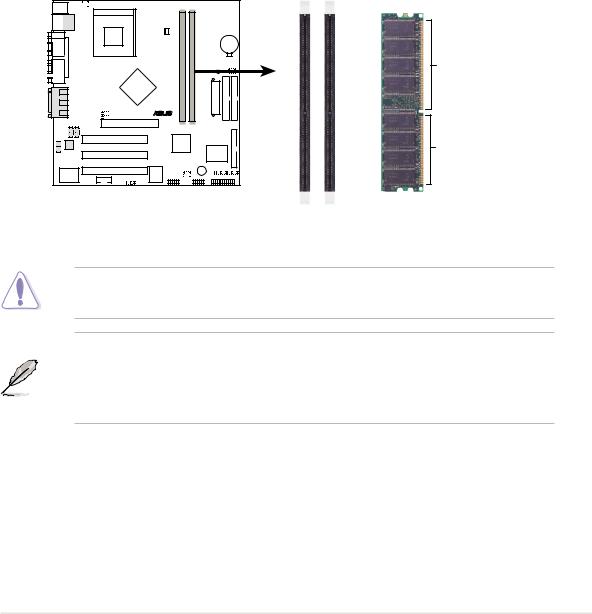
2.5System memory
2.5.1 Overview
This motherboard uses only Double Data Rate (DDR) Synchronous Dynamic Random Access Memory (SDRAM) Dual Inline Memory Modules (DIMMs). These sockets support up to 1GB system memory using non-ECC PC200/ 266 DIMMs.
Each DIMM socket/module is two-sided: each side defines one “row” of memory. DIMMs come in combinations of single or double-sided types ranging through 64MB, 128MB, 256MB, 512MB
to form a total memory size of 64MB to 1GB.
~ Two (2) sockets are available for both 266MHz-PC2100 or 200MHz-PC1600 DDR DIMMs to form a memory size of 64MB to 1GB.
A7N266-VM |
104 Pins
80 Pins
A7N266-VM 184-Pin DDR
DIMM Sockets
CAUTION! DIMMs are keyed to fit into notches with only one direction. DO NOT force a DIMM into a socket to avoid damaging the DIMM.
•DIMMs with more than 18 chips are not supported.
•ASUS motherboards support SPD (Serial Presence Detect)DIMMs. This is the memory of choice for best performance vs. stability
•BIOS shows DDR SDRAM memory on bootup screen.
ASUS A7N266-VM motherboard user guide |
13 |
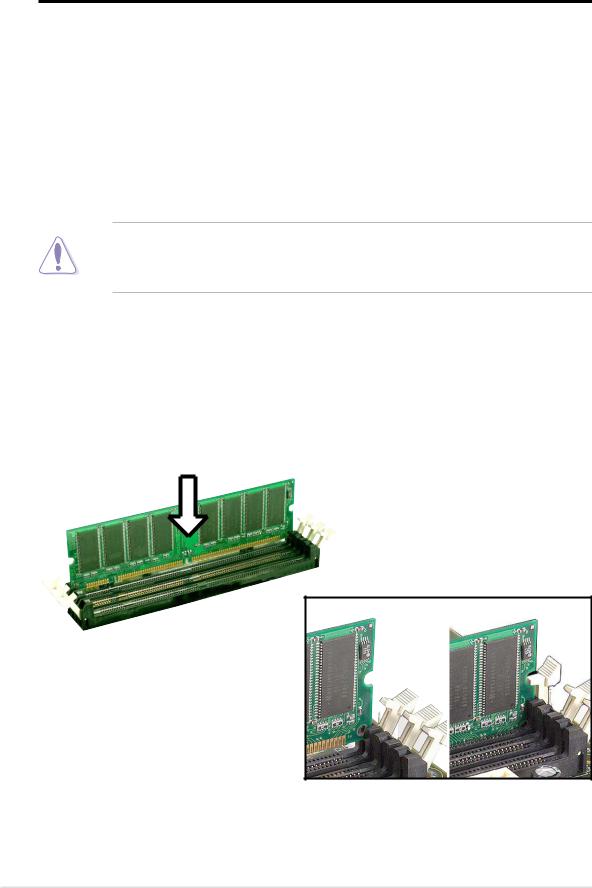
2.5.2 Memory configurations
Install DIMMs in any of the following combinations.
DIMM Location |
184-pin DIMM (DDR) |
Total Memory |
Socket 1 (Rows 0&1) 64MB, 128MB, 256MB, 512MB |
x1 |
|
|
|
|
Socket 2 (Rows 2&3) 64MB, 128MB, 256MB, 512MB |
x1 |
|
|
|
|
Total system memory (Max. 1GB) |
= |
|
|
|
|
2.5.3 Installing a DIMM
CAUTION! Make sure to unplug the power supply before adding or removing DIMMs or other system components. Failure to do so may cause severe damage to both the motherboard and the components.
Installing a DIMM:
1.Unlock a DIMM socket by pressing the retaining clips outward.
2.Align a DIMM on the socket such that the notches on the DIMM exactly match the notches in the socket.
3.Firmly insert the DIMM into the socket until the retaining clips snap back in place.
Unlocked Retaining Clip |
Locked Retaining Clip |
14 |
Chapter 2: Hardware information |
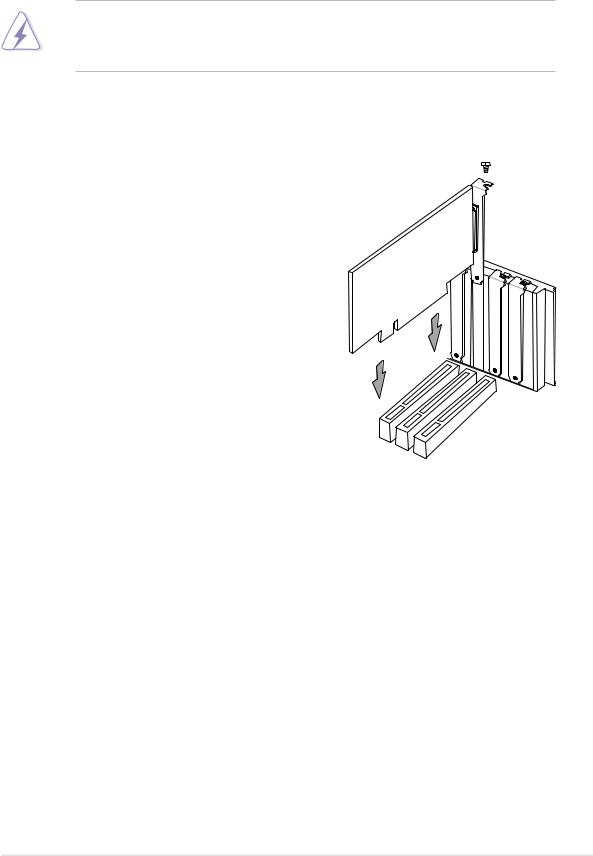
2.6Expansion slots
The motherboard has three PCI slots and one Accelerated Graphics Port (AGP) slot.. The following sub-sections describe the slots and the expansion cards that they support.
WARNING! Unplug your power supply when adding or removing expansion cards or other system components. Failure to do so may cause you physical injury and damage motherboard components.
2.6.1 Installing an expansion card
Follow these steps to install an expansion card.
1.Before installing the expansion card, read the documentation that came with it and make the necessary hardware settings.
2.Remove the system unit cover (if your motherboard is already installed in a chassis).
3.Remove the bracket opposite the PCI slot. Keep the screw for later use.
4.Align the card connector with the slot and press firmly until the card is completely seated on the slot.
5.Secure the card to the chassis with the screw you removed earlier.
6.Replace the system cover.
7.Set up the BIOS if necessary.
8.Install the necessary software drivers for your expansion card.
ASUS A7N266-VM motherboard user guide |
15 |

2.6.2 Configuring an expansion card
Some expansion cards need an IRQ to operate. Generally, an IRQ must be exclusively assigned to one function at a time. In a standard design configuration, 16 IRQs are available but most are already in use. Normally, 6 IRQs are free for expansion cards. If the motherboard has PCI audio onboard, an additional IRQ will be used. If your motherboard also has MIDI enabled, another IRQ will be used, leaving 4 IRQs free. Sometimes IRQs are “shared” by more than one function; in this case, IRQ assignments are swapped automatically or adjusted through the BIOS firmware.
IMPORTANT! When using PCI cards on shared slots, ensure that the drivers support “Share IRQ” or that the cards do not need IRQ assignments. Otherwise, conflicts will arise between the three PCI groups, making the system unstable and the card inoperative.
Standard Interrupt Assignments
IRQ |
Priority |
Standard Function |
0 |
1 |
System Timer |
1 |
2 |
Keyboard Controller |
2 |
N/A |
Programmable Interrupt |
3* |
11 |
Communications Port (COM2) |
4* |
12 |
Communications Port (COM1) |
5* |
13 |
Sound Card (sometimes LPT2) |
6 |
14 |
Floppy Disk Controller |
7* |
15 |
Printer Port (LPT1) |
8 |
3 |
System CMOS/Real Time Clock |
9* |
4 |
ACPI Mode when used |
10* |
5 |
IRQ Holder for PCI Steering |
11* |
6 |
IRQ Holder for PCI Steering |
12* |
7 |
PS/2 Compatible Mouse Port |
13 |
8 |
Numeric Data Processor |
14* |
9 |
Primary IDE Channel |
15* |
10 |
Secondary IDE Channel |
*These IRQs are usually available for ISA or PCI devices.
16 |
Chapter 2: Hardware information |

Interrupt Request Table for this Motherboard
INT-A INT-B INT-C INT-D INT-E |
INT-F INT-G INT-H |
INT-I |
||||||||||
|
|
|
|
|
|
|
|
|
|
|
|
|
PCI slot 1 |
used |
— |
— |
— |
— |
— |
— |
|
— |
— |
|
|
PCI slot 2 |
— |
— |
— |
used |
— |
— |
|
— |
— |
— |
|
|
PCI slot 3 |
— |
— |
used |
— |
|
— |
— |
— |
— |
— |
|
|
Onboard USB0 — |
— |
— |
— |
— |
|
shared |
— |
— |
— |
|
||
Onboard USB1 |
— |
— |
— |
— |
— |
|
shared |
— |
— |
|
used |
|
Onboard Audio |
— |
— |
— |
— |
|
used |
— |
|
— |
— |
— |
|
Onboard Modem— |
— |
— |
— |
— |
— |
— |
|
|
used |
— |
||
2.6.3 PCI slots
Three 32-bit PCI slots are available on this motherboard. The slots support PCI cards such as a LAN card, SCSI card, USB card, and other cards that comply with PCI specifications.
This figure shows a typical PCI card installed into a slot:
ASUS A7N266-VM motherboard user guide |
17 |

2.6.4 AGP slot
This motherboard provides an Accelerated Graphics Port (AGP 4X) slot to support AGP graphics cards. Take note of the notches on the card golden fingers to ensure that they fit the AGP slot on your motherboard. Below is an example of a +1.5V AGP card.
A7N266-VM
Keyed for 1.5v
A7N266-VM Accelerated Graphics Port (AGP)
CAUTION! To avoid damaging your AGP graphics card, your computer’s power supply should be unplugged before inserting your graphics card into the slot.
18 |
Chapter 2: Hardware information |
